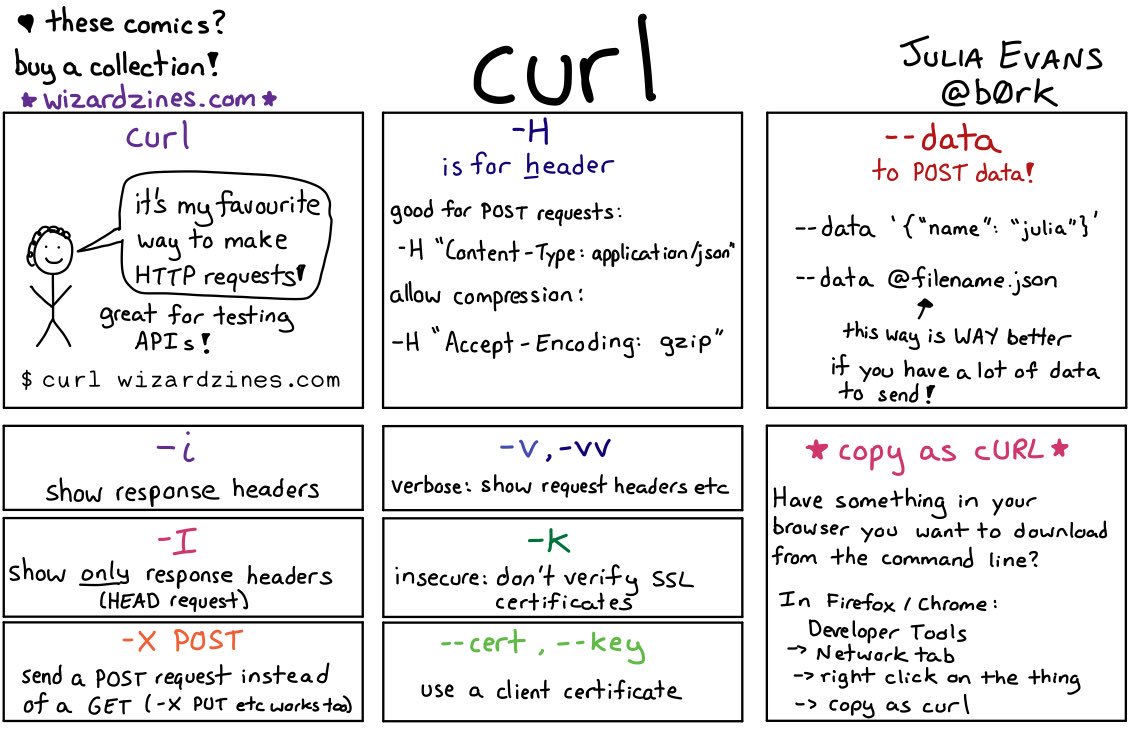curl exercises
Recently I’ve been interested in how people learn things. I was reading Kathy Sierra’s great book Badass: Making Users Awesome. It talks about the idea of deliberate practice.
The idea is that you find a small micro-skill that can be learned in maybe 3 sessions of 45 minutes, and focus on learning that micro-skill. So, as an exercise, I was trying to think of a computer skill that I thought could be learned in 3 45-minute sessions.
I thought that making HTTP requests with curl might be a skill like that, so here are some curl
exercises as an experiment!
what’s curl?
curl is a command line tool for making HTTP requests. I like it because it’s an easy way to test that servers or APIs are doing what I think, but it’s a little confusing at first!
Here’s a drawing explaining curl’s most important command line arguments (which is page 6 of my Bite Size Networking zine). You can click to make it bigger.
fluency is valuable
With any command line tool, I think having fluency is really helpful. It’s really nice to be able to just type in the thing you need. For example recently I was testing out the Gumroad API and I was able to just type in:
curl https://api.gumroad.com/v2/sales \
-d "access_token=<SECRET>" \
-X GET -d "before=2016-09-03"
and get things working from the command line.
21 curl exercises
These exercises are about understanding how to make different kinds of HTTP requests with curl. They’re a little repetitive on purpose. They exercise basically everything I do with curl.
To keep it simple, we’re going to make a lot of our requests to the same website: https://httpbin.org. httpbin is a service that accepts HTTP requests and then tells you what request you made.
- Request https://httpbin.org
- Request https://httpbin.org/anything. httpbin.org/anything will look at the request you made, parse it, and echo back to you what you requested. curl’s default is to make a GET request.
- Make a POST request to https://httpbin.org/anything
- Make a GET request to https://httpbin.org/anything, but this time add some query parameters (set
value=panda). - Request google’s robots.txt file (www.google.com/robots.txt)
- Make a GET request to https://httpbin.org/anything and set the header
User-Agent: elephant. - Make a DELETE request to https://httpbin.org/anything
- Request https://httpbin.org/anything and also get the response headers
- Make a POST request to https://httpbin.org/anything with the JSON body
{"value": "panda"} - Make the same POST request as the previous exercise, but set the Content-Type header to
application/json(because POST requests need to have a content type that matches their body). Look at thejsonfield in the response to see the difference from the previous one. - Make a GET request to https://httpbin.org/anything and set the header
Accept-Encoding: gzip(what happens? why?) - Put a bunch of a JSON in a file and then make a POST request to https://httpbin.org/anything with the JSON in that file as the body
- Make a request to https://httpbin.org/image and set the header ‘Accept: image/png’. Save the
output to a PNG file and open the file in an image viewer. Try the same thing with different
Accept:headers. - Make a PUT request to https://httpbin.org/anything
- Request https://httpbin.org/image/jpeg, save it to a file, and open that file in your image editor.
- Request https://www.twitter.com. You’ll get an empty response. Get curl to show you the response headers too, and try to figure out why the response was empty.
- Make any request to https://httpbin.org/anything and just set some nonsense headers (like
panda: elephant) - Request https://httpbin.org/status/404 and https://httpbin.org/status/200. Request them again and get curl to show the response headers.
- Request https://httpbin.org/anything and set a username and password (with
-u username:password) - Download the Twitter homepage (https://twitter.com) in Spanish by setting the
Accept-Language: es-ESheader. - Make a request to the Stripe API with curl. (see https://stripe.com/docs/development for how, they give you a test API key). Try making exactly the same request to https://httpbin.org/anything.
